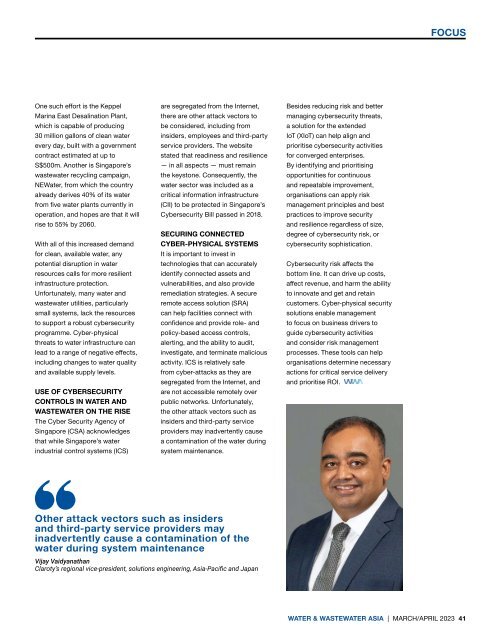Water & Wastewater Asia March/April 2023
Water & Wastewater Asia is an expert source of industry information, cementing its position as an indispensable tool for trade professionals in the water and wastewater industry. As the most reliable publication in the region, industry experts turn this premium journal for credible journalism and exclusive insight provided by fellow industry professionals. Water & Wastewater Asia incorporates the official newsletter of the Singapore Water Association (SWA).
Water & Wastewater Asia is an expert source of industry information, cementing its position as an indispensable tool for trade professionals in the water and wastewater industry. As the most reliable publication in the region, industry experts turn this premium journal for credible journalism and exclusive insight provided by fellow industry professionals. Water & Wastewater Asia incorporates the official newsletter of the Singapore Water Association (SWA).
You also want an ePaper? Increase the reach of your titles
YUMPU automatically turns print PDFs into web optimized ePapers that Google loves.
FOCUS<br />
One such effort is the Keppel<br />
Marina East Desalination Plant,<br />
which is capable of producing<br />
30 million gallons of clean water<br />
every day, built with a government<br />
contract estimated at up to<br />
S$500m. Another is Singapore’s<br />
wastewater recycling campaign,<br />
NE<strong>Water</strong>, from which the country<br />
already derives 40% of its water<br />
from five water plants currently in<br />
operation, and hopes are that it will<br />
rise to 55% by 2060.<br />
With all of this increased demand<br />
for clean, available water, any<br />
potential disruption in water<br />
resources calls for more resilient<br />
infrastructure protection.<br />
Unfortunately, many water and<br />
wastewater utilities, particularly<br />
small systems, lack the resources<br />
to support a robust cybersecurity<br />
programme. Cyber-physical<br />
threats to water infrastructure can<br />
lead to a range of negative effects,<br />
including changes to water quality<br />
and available supply levels.<br />
USE OF CYBERSECURITY<br />
CONTROLS IN WATER AND<br />
WASTEWATER ON THE RISE<br />
The Cyber Security Agency of<br />
Singapore (CSA) acknowledges<br />
that while Singapore’s water<br />
industrial control systems (ICS)<br />
are segregated from the Internet,<br />
there are other attack vectors to<br />
be considered, including from<br />
insiders, employees and third-party<br />
service providers. The website<br />
stated that readiness and resilience<br />
— in all aspects — must remain<br />
the keystone. Consequently, the<br />
water sector was included as a<br />
critical information infrastructure<br />
(CII) to be protected in Singapore’s<br />
Cybersecurity Bill passed in 2018.<br />
SECURING CONNECTED<br />
CYBER-PHYSICAL SYSTEMS<br />
It is important to invest in<br />
technologies that can accurately<br />
identify connected assets and<br />
vulnerabilities, and also provide<br />
remediation strategies. A secure<br />
remote access solution (SRA)<br />
can help facilities connect with<br />
confidence and provide role- and<br />
policy-based access controls,<br />
alerting, and the ability to audit,<br />
investigate, and terminate malicious<br />
activity. ICS is relatively safe<br />
from cyber-attacks as they are<br />
segregated from the Internet, and<br />
are not accessible remotely over<br />
public networks. Unfortunately,<br />
the other attack vectors such as<br />
insiders and third-party service<br />
providers may inadvertently cause<br />
a contamination of the water during<br />
system maintenance.<br />
Besides reducing risk and better<br />
managing cybersecurity threats,<br />
a solution for the extended<br />
IoT (XIoT) can help align and<br />
prioritise cybersecurity activities<br />
for converged enterprises.<br />
By identifying and prioritising<br />
opportunities for continuous<br />
and repeatable improvement,<br />
organisations can apply risk<br />
management principles and best<br />
practices to improve security<br />
and resilience regardless of size,<br />
degree of cybersecurity risk, or<br />
cybersecurity sophistication.<br />
Cybersecurity risk affects the<br />
bottom line. It can drive up costs,<br />
affect revenue, and harm the ability<br />
to innovate and get and retain<br />
customers. Cyber-physical security<br />
solutions enable management<br />
to focus on business drivers to<br />
guide cybersecurity activities<br />
and consider risk management<br />
processes. These tools can help<br />
organisations determine necessary<br />
actions for critical service delivery<br />
and prioritise ROI.<br />
Other attack vectors such as insiders<br />
and third-party service providers may<br />
inadvertently cause a contamination of the<br />
water during system maintenance<br />
Vijay Vaidyanathan<br />
Claroty’s regional vice-president, solutions engineering, <strong>Asia</strong>-Pacific and Japan<br />
WATER & WASTEWATER ASIA | MARCH/APRIL <strong>2023</strong> 41


















